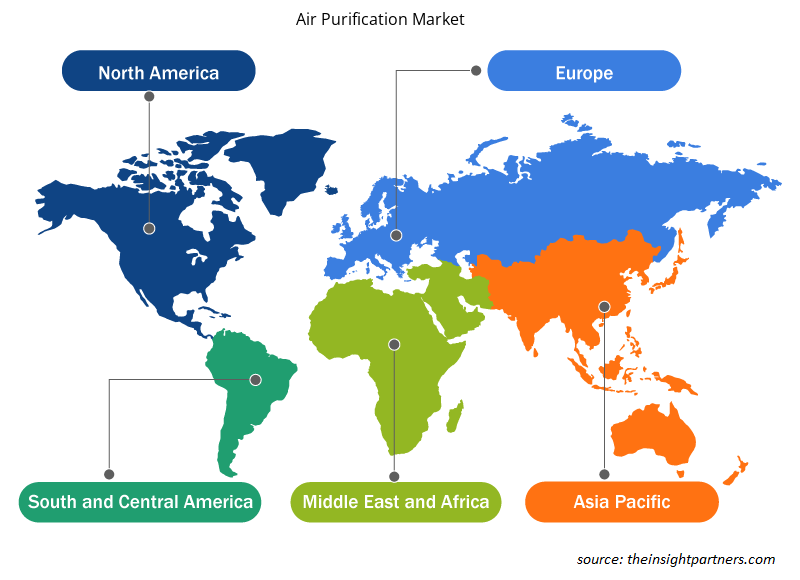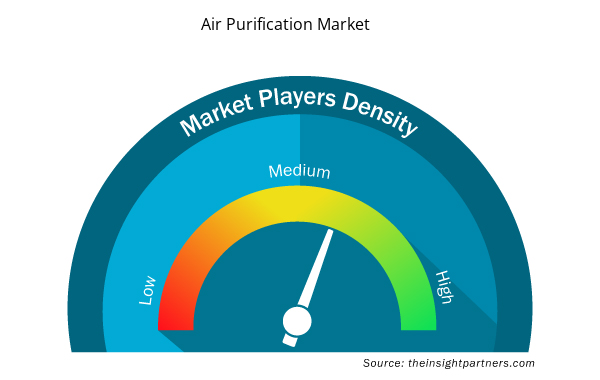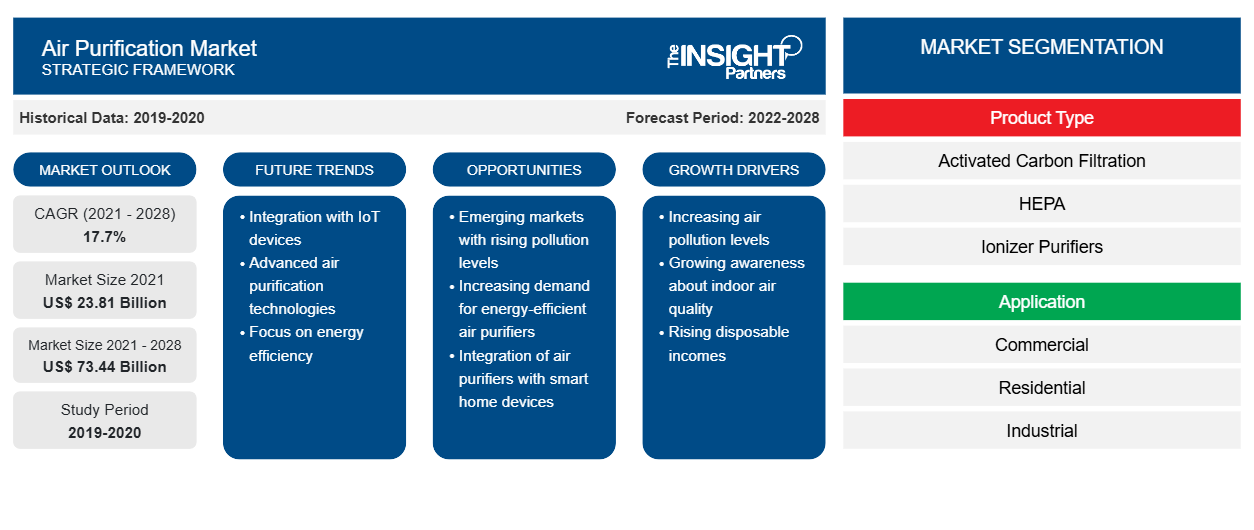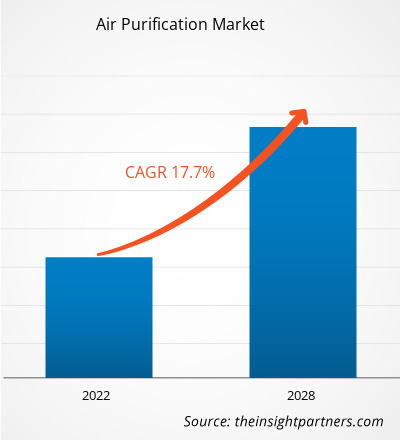空气净化市场预计将从 2021 年的 238.0952 亿美元增长到 2028 年的 734.3736 亿美元。预计 2021 年至 2028 年的复合年增长率为 17.7%。
由于空气污染加剧导致空气传播疾病增加,这是市场增长的一个关键因素。此外,消费者对使用空气净化器的认识不断提高、可支配收入增加和生活水平提高是推动市场增长的主要因素。在预测期内,采用便携式和智能空气净化器的趋势日益增长,进一步推动了市场的发展。政府在排放标准、劳动力健康和安全法规执行以及现有空气纯度政策修订方面的支持性举措进一步增强了空气净化市场的市场活力。例如,2021 年 8 月,印度计划在 2022 年重新制定新的国家环境空气质量标准 (NAAQS)。
新标准包括超细颗粒物成分,在更多污染物下,其浓度低于 PM2.5。此外,2021 年 9 月,世界卫生组织 (WHO) 推出了新的全球空气质量指南 (AQG),旨在通过降低导致气候变化的主要空气污染物水平来保护民众的健康。因此,此类举措进一步增加了对空气净化产品的需求,推动了预测期内的市场前景。
全球对便携式空气过滤器的需求是推动市场增长的关键趋势。生活方式的改变直接影响人们的健康,增加了对空气净化产品的需求。便携式空气净化器采用 HEPA-13 过滤器、碳过滤器和上述过滤器上的抗菌涂层来防止细菌生长。这些过滤器非常有效,而且在采用方面呈趋势。污染水平的上升和空气传播疾病的增加加速了对便携式空气过滤器的需求。西蒙弗雷泽大学研究人员的研究发现,在家中配备便携式空气净化器可以减少空气污染对儿童大脑发育的负面影响。对便携式空气过滤器的持续投资正在帮助市场蓬勃发展。
空气净化市场研究主要关注两个领域,即产品类型和应用。产品类型细分进一步细分为活性炭过滤、高效微粒空气 (HEPA)、离子净化器、紫外线杀菌照射 (UVGI) 等。应用细分进一步细分为商业、住宅和工业。按地域划分,市场细分为北美、欧洲、亚太地区、中东和非洲以及南美。
定制此报告以满足您的需求
您可以免费定制任何报告,包括本报告的部分内容、国家级分析、Excel 数据包,以及为初创企业和大学提供优惠和折扣
- 获取此报告的关键市场趋势。这个免费样品将包括数据分析,从市场趋势到估计和预测。
COVID-19 疫情对空气净化市场的影响
丹麦、波兰和法国是空气污染程度较高的国家。欧洲各国政府出台了关于在住宅和商业领域开发环保建筑的法规,对环境产生了积极影响。该地区是工业设备、汽车、建筑、能源和电力行业的主要制造和工业中心。然而,由于 2020 年企业停工、旅行禁令和供应链中断,该地区的一些行业有所衰退,空气污染显著减少。然而,人们对 SARS-CoV-2 安全性的担忧日益增加,增加了对空气净化的需求。
2020 年,政府实施的封锁措施使人们只能待在室内,从而推动了家用空气净化器的销售。各国际空气净化器制造商都将疫情视为机遇。例如,由于欧洲地区对空气净化器的需求不断增长,韩国空气净化器巨头 Coway 已将业务扩展到欧洲。该公司接管了 Serviceplan 的整合团队和 Plan.Net 机构的部门。因此,日益严重的空气污染以及病毒和细菌造成的污染为欧洲空气净化器市场参与者提供了增长机会。
市场洞察 - 空气净化市场
城市化和工业化的不断推进推动了市场的增长
城市化进程的加快必然会增加住宅和商业应用中对大型空气过滤器产品的需求,这将有助于在预测期内推动市场增长。发展中经济体国家的城市化进程加快。人口的增长也有助于人们向城市化转变,从而推动市场增长。根据世界银行集团的数据,到 2045 年,世界城市人口将增加 1.5 倍,达到 60 亿。此外,根据世界经济论坛的数据,到 2050 年,世界城市人口预计将从 2022 年的 55% 上升到 80%。亚太地区国家在未来几年拥有前所未有的机会,通过提高城市化水平来促进经济发展。发展中经济体人民的收入和支出能力不断增长,以及汽车、医疗保健、建筑、制造业、能源和公用事业等各种终端使用领域的需求不断增长,是推动空气净化市场增长的主要因素。城市化进程的加快包括学校、大学、医院、商业综合体、住宅等的扩张,这些因素导致了对清洁空气的需求,从而推动了市场的发展。城市化进程的加快导致了巨大的室内和室外空气污染,这进一步加剧了对空气净化器的需求
基于产品类型的洞察
根据产品类型,空气净化市场细分为活性炭过滤、高效微粒空气 (HEPA)、离子净化器、紫外线杀菌照射 (UVGI) 等。由于半导体和微电子等各行业的需求不断增长,HEPA 部分在 2021 年占据了最大的市场份额。
基于应用的洞察
根据应用,空气净化市场分为商业、住宅和工业。商业领域在 2021 年占据了最大的市场份额。
空气净化市场区域洞察
Insight Partners 的分析师已详尽解释了预测期内影响空气净化市场的区域趋势和因素。本节还讨论了北美、欧洲、亚太地区、中东和非洲以及南美和中美洲的空气净化市场细分和地理位置。

- 获取空气净化市场的区域具体数据
空气净化市场报告范围
| 报告属性 | 细节 |
|---|---|
| 2021 年市场规模 | 238.1亿美元 |
| 2028 年市场规模 | 734.4 亿美元 |
| 全球复合年增长率(2021 - 2028) | 17.7% |
| 史料 | 2019-2020 |
| 预测期 | 2022-2028 |
| 涵盖的领域 | 按产品类型
|
| 覆盖地区和国家 | 北美
|
| 市场领导者和主要公司简介 |
|
空气净化市场参与者密度:了解其对业务动态的影响
空气净化市场正在快速增长,这得益于终端用户需求的不断增长,而这些需求又源于消费者偏好的不断变化、技术进步以及对产品优势的认识不断提高等因素。随着需求的增加,企业正在扩大其产品范围,进行创新以满足消费者的需求,并利用新兴趋势,从而进一步推动市场增长。
市场参与者密度是指在特定市场或行业内运营的企业或公司的分布情况。它表明在给定市场空间中,相对于其规模或总市场价值,有多少竞争对手(市场参与者)存在。
在空气净化市场运营的主要公司有:
- 惠而浦公司
- 康斐尔
- 大金工业株式会社
- 霍尼韦尔国际公司
- 荷兰皇家飞利浦公司
免责声明:上面列出的公司没有按照任何特定顺序排列。

- 了解空气净化市场主要参与者概况
空气净化市场的参与者主要致力于开发先进、高效的产品。
- 2019年11月,荷兰皇家飞利浦旗下的飞利浦印度公司在印度市场推出了空气净化器-800系列。这使得飞利浦能够提供多个价格区间的空气净化器。
- 2021 年 5 月,大金推出了空气净化器,这是一款便携式室内空气净化器,旨在提高中东和非洲的室内空气质量。该公司推出了两种型号,分别是高级型号和经济型号。
公司名单
- ACTIVEPURE TECHNOLOGIES LLC
- 惠而浦公司
- 康菲尔
- 大金工业株式会社
- 霍尼韦尔国际有限公司
- IQAIR 北美公司
- 荷兰皇家飞利浦公司
- LG 电子公司
- 松下公司
- 联合利华有限公司
- 历史分析(2 年)、基准年、预测(7 年)及复合年增长率
- PEST 和 SWOT 分析
- 市场规模价值/数量 - 全球、区域、国家
- 行业和竞争格局
- Excel 数据集


- Equipment Rental Software Market
- HVAC Sensors Market
- Artificial Intelligence in Healthcare Diagnosis Market
- Digital Pathology Market
- Pressure Vessel Composite Materials Market
- Foot Orthotic Insoles Market
- Dry Eye Products Market
- Biopharmaceutical Tubing Market
- Resistance Bands Market
- Virtual Production Market

Report Coverage
Revenue forecast, Company Analysis, Industry landscape, Growth factors, and Trends

Segment Covered
This text is related
to segments covered.

Regional Scope
North America, Europe, Asia Pacific, Middle East & Africa, South & Central America

Country Scope
This text is related
to country scope.
常见问题
The estimated market size for the air purification market was US$ 23,809.52 million in 2021.
The incremental growth of the air purification market is 17.7% during 2022 to 2028.
Rising adoption of portable residential air filter are the key trending factors driving the market growth.
Rising urbanization & industrialization and supportive government regulations and policies for improving the air quality are the key factors driving the air purification market over the forecast period.
The key companies operating in the air purification market that are profiled in the report include Whirlpool Corporation; Camfil; DAIKIN INDUSTRIES, Ltd.; Honeywell International Inc.; Koninklijke Philips N.V.; LG Electronics; Panasonic Corporation; Unilever PLC; ActivePure Technologies, LLC.; IQAir.
China, Germany, and South Korea are the prominent countries registered the highest growth rate of 23.1%, 22.6%, and 20.7% respectively, during the forecast period.
High-efficiency Particulate Air (HEPA) segment is holding larger market share during the forecast period.
Asia Pacific region is the fastest growing regional air purification market.
The global market size for air purification market will be US$ 73,437.36 million in 2028.
Trends and growth analysis reports related to Manufacturing and Construction : READ MORE..
The List of Companies - Air Purification Market
- Whirlpool Corporation
- Camfil
- DAIKIN INDUSTRIES, Ltd.
- Honeywell International Inc.
- Koninklijke Philips N.V.
- LG Electronics
- Panasonic Corporation
- Unilever PLC
- ActivePure Technologies, LLC.
- IQAir
The Insight Partners performs research in 4 major stages: Data Collection & Secondary Research, Primary Research, Data Analysis and Data Triangulation & Final Review.
- Data Collection and Secondary Research:
As a market research and consulting firm operating from a decade, we have published and advised several client across the globe. First step for any study will start with an assessment of currently available data and insights from existing reports. Further, historical and current market information is collected from Investor Presentations, Annual Reports, SEC Filings, etc., and other information related to company’s performance and market positioning are gathered from Paid Databases (Factiva, Hoovers, and Reuters) and various other publications available in public domain.
Several associations trade associates, technical forums, institutes, societies and organization are accessed to gain technical as well as market related insights through their publications such as research papers, blogs and press releases related to the studies are referred to get cues about the market. Further, white papers, journals, magazines, and other news articles published in last 3 years are scrutinized and analyzed to understand the current market trends.
- Primary Research:
The primarily interview analysis comprise of data obtained from industry participants interview and answers to survey questions gathered by in-house primary team.
For primary research, interviews are conducted with industry experts/CEOs/Marketing Managers/VPs/Subject Matter Experts from both demand and supply side to get a 360-degree view of the market. The primary team conducts several interviews based on the complexity of the markets to understand the various market trends and dynamics which makes research more credible and precise.
A typical research interview fulfils the following functions:
- Provides first-hand information on the market size, market trends, growth trends, competitive landscape, and outlook
- Validates and strengthens in-house secondary research findings
- Develops the analysis team’s expertise and market understanding
Primary research involves email interactions and telephone interviews for each market, category, segment, and sub-segment across geographies. The participants who typically take part in such a process include, but are not limited to:
- Industry participants: VPs, business development managers, market intelligence managers and national sales managers
- Outside experts: Valuation experts, research analysts and key opinion leaders specializing in the electronics and semiconductor industry.
Below is the breakup of our primary respondents by company, designation, and region:

Once we receive the confirmation from primary research sources or primary respondents, we finalize the base year market estimation and forecast the data as per the macroeconomic and microeconomic factors assessed during data collection.
- Data Analysis:
Once data is validated through both secondary as well as primary respondents, we finalize the market estimations by hypothesis formulation and factor analysis at regional and country level.
- Macro-Economic Factor Analysis:
We analyse macroeconomic indicators such the gross domestic product (GDP), increase in the demand for goods and services across industries, technological advancement, regional economic growth, governmental policies, the influence of COVID-19, PEST analysis, and other aspects. This analysis aids in setting benchmarks for various nations/regions and approximating market splits. Additionally, the general trend of the aforementioned components aid in determining the market's development possibilities.
- Country Level Data:
Various factors that are especially aligned to the country are taken into account to determine the market size for a certain area and country, including the presence of vendors, such as headquarters and offices, the country's GDP, demand patterns, and industry growth. To comprehend the market dynamics for the nation, a number of growth variables, inhibitors, application areas, and current market trends are researched. The aforementioned elements aid in determining the country's overall market's growth potential.
- Company Profile:
The “Table of Contents” is formulated by listing and analyzing more than 25 - 30 companies operating in the market ecosystem across geographies. However, we profile only 10 companies as a standard practice in our syndicate reports. These 10 companies comprise leading, emerging, and regional players. Nonetheless, our analysis is not restricted to the 10 listed companies, we also analyze other companies present in the market to develop a holistic view and understand the prevailing trends. The “Company Profiles” section in the report covers key facts, business description, products & services, financial information, SWOT analysis, and key developments. The financial information presented is extracted from the annual reports and official documents of the publicly listed companies. Upon collecting the information for the sections of respective companies, we verify them via various primary sources and then compile the data in respective company profiles. The company level information helps us in deriving the base number as well as in forecasting the market size.
- Developing Base Number:
Aggregation of sales statistics (2020-2022) and macro-economic factor, and other secondary and primary research insights are utilized to arrive at base number and related market shares for 2022. The data gaps are identified in this step and relevant market data is analyzed, collected from paid primary interviews or databases. On finalizing the base year market size, forecasts are developed on the basis of macro-economic, industry and market growth factors and company level analysis.
- Data Triangulation and Final Review:
The market findings and base year market size calculations are validated from supply as well as demand side. Demand side validations are based on macro-economic factor analysis and benchmarks for respective regions and countries. In case of supply side validations, revenues of major companies are estimated (in case not available) based on industry benchmark, approximate number of employees, product portfolio, and primary interviews revenues are gathered. Further revenue from target product/service segment is assessed to avoid overshooting of market statistics. In case of heavy deviations between supply and demand side values, all thes steps are repeated to achieve synchronization.
We follow an iterative model, wherein we share our research findings with Subject Matter Experts (SME’s) and Key Opinion Leaders (KOLs) until consensus view of the market is not formulated – this model negates any drastic deviation in the opinions of experts. Only validated and universally acceptable research findings are quoted in our reports.
We have important check points that we use to validate our research findings – which we call – data triangulation, where we validate the information, we generate from secondary sources with primary interviews and then we re-validate with our internal data bases and Subject matter experts. This comprehensive model enables us to deliver high quality, reliable data in shortest possible time.


 获取此报告的免费样本
获取此报告的免费样本